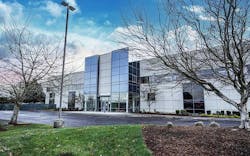Portland Emerges as the Hot Data Center Market for the Pacific Northwest
A new special report from Data Center Frontier explores how Portland, Ore., has emerged as a leading market for multi-tenant data center development in the Pacific Northwest. This first entry in a DCF article series highlights a general market view and analysis of the Portland data center market, as well as colo supply and demand trends in the region.
Get the full report.
The Pacific Northwest region is poised for substantial growth over the next several years, and data center developers clearly see Portland as a future hot spot for hyperscale and enterprise facilities.
While not yet a major market, Portland has a rising profile as a destination for data centers. The region benefits from a favorable cost environment — including a prominent enterprise zone and Oregon’s business-friendly tax policies—as well as a climate that’s ideal for keeping servers cool. That’s attractive to sustainability-aware enterprises, who also like the region’s ample supply of renewable energy.
The Portland market is home to more than 354,283 square feet (SF) of commissioned data center space, representing 57.81 megawatts (MW) of commissioned power, according to market research from datacenterHawk.
The real news about Portland is not so much its present, but its future. Data center developers plan to deploy 275 megawatts of new data center capacity in coming years, representing 1.33 million square feet of new space.
Data center development in the Portland market is focused on Hillsboro, a northern suburb that is home to a large Intel semiconductor fabrication facility. The adjacent Enterprise Zone offers tax benefits and abundant power, making the area a magnet for data center development. Tax breaks saved Hillsboro data center operators and customers $3.1 million in 2019 and $5.4 million in 2018, according to state records.
The Intel campus is surrounded by data center projects for the leading players in data center development, including Digital Realty, NTT Global Data Centers Americas, Stack Infrastructure, QTS Data Centers, EdgeConneX and Flexential, among others.
Much of the optimism around Portland’s growth stems from the belief that it will become a leading alternative to California, which boasts a large concentration of data centers. The California market has been roiled by the troubles of utility PG&E, which filed for bankruptcy protection in 2019 due to wildfire-related liabilities. The prospect of higher future utility bills, along with PG&E’s imposition of rolling service outages during periods of heightened wildfire risk, has customers looking beyond California’s borders for their West Coast data center workloads.
Oregon’s power is not only cheaper than California, but greener as well. Portland utility PGE has a number of programs providing 100 percent renewable energy to data center operators, including solar and wind generation facilities and an ample supply of hydro-electric power.
A key factor in the future of the Portland cluster is how it fares in the fierce competition to woo data center users exiting California. Data center providers in Las Vegas and Phoenix compete aggressively for business from California-based customers, while the Pacific Northwest offers several other attractive options for large single-tenant requirements, including Quincy, Washington and Prineville, Oregon.
The consensus is that the data center industry will see strong demand for network services to support the shift to digital platforms, which will likely outweigh any loss of business from sectors that are hard-hit by COVID-19 lockdowns.
A meaningful differentiator is Hillsboro’s direct access to trans-Pacific subsea cables offering connectivity to fast-growing cities in the Asia-Pacific region, which are a key growth market for many customers.
On a broad scale, the COVID-19 Coronavirus pandemic has reinforced the importance of data centers and cloud computing for our society. In the early days of the crisis, the data center industry has served as the backstop for the global economy, supporting a massive shift to online services for businesses, schools and non-profits.
The consensus is that the data center industry will see strong demand for network services to support the shift to digital platforms, which will likely outweigh any loss of business from sectors that are hard-hit by COVID-19 lockdowns. A key question is how the pandemic’s evolution will impact data center construction, as well as the ability to conduct tours of properties—both of which will impact the industry’s execution over the long haul.
Trends in Demand
Although Portland is considered a secondary data center market (especially compared to nearby large primary markets Seattle and Northern California), data center users increasingly find the market attractive.
- Growing Economy The Portland economy continues to increase, with 3.3% annual employment growth.
- Growing Technology Sector Much of Portland’s economy comes from high-tech manufacturing and IT jobs. The Hillsboro sub-market also has business clusters of firms specializing in advanced manufacturing and biotechnology.
- Heavy Data Center Tax Incentives Portland’s data center tax is the 2nd lowest in the United States. The tax incentives are available in Portland’s suburban “enterprise zones.” Oregon does not have a sales tax.
- Lower Seismic Threat Compared to other West Coast markets, the seismic threat in the greater Portland area is relatively low.
- Access to Subsea Cables Portland data centers have access to several trans-Pacific subsea cables, an option not available in competing markets in interior U.S. states. An ultra-high count fiber ring joins all the major local data centers and businesses, and serves as a cross connect for cables including FASTER, TPE, TGN, Hawaiki and New Cross Pacific that reduce latency to high-value Asia-Pacific markets.
The recent investments in the area made by enterprise users and colocation providers are indicative of large-scale future growth for Portland. The main data center development has occurred in the Portland suburb of Hillsboro, where heavy investments from Intel led to growing interest in the region.
Colocation and data center development was originally started by Stack Infrastructure (formerly Infomart Data Centers) and Digital Realty’s data center construction in 2011–2012. Other providers, such as T5 Data Centers, Telx (acquired by Digital Realty in 2015), and ViaWest (now Flexential) quickly saw the value in the market, causing a jump to 36 MW of capacity delivered to Portland. Other providers followed, boosting the Portland market to the current 58 MW of commissioned power. More recently, both incumbent providers and new players have acquired land to add further capacity.
Explore the Portland colocation market further through Data Center Frontier’s special report series over the next few weeks and ongoing coverage of the growing colocation industry in the Pacific Northwest region.We will cover the general business environment, a focus on technology, a supply overview, hazard risk info and more.
And see the full report,“2020 Data Center Market Overview Portland.”






